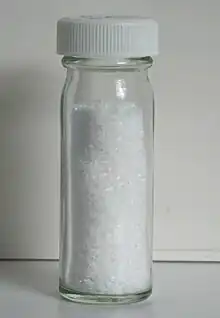Caesium perchlorate
Caesium perchlorate or cesium perchlorate (CsClO4), is a perchlorate of caesium. It forms white crystals, which are sparingly soluble in cold water and ethanol. It dissolves more easily in hot water.
 | |
 | |
| Names | |
|---|---|
| IUPAC name
Caesium perchlorate | |
| Other names
Cesium perchlorate | |
| Identifiers | |
3D model (JSmol) |
|
| ChemSpider | |
| ECHA InfoCard | 100.033.298 |
| EC Number |
|
PubChem CID |
|
CompTox Dashboard (EPA) |
|
| |
| |
| Properties | |
| CsClO4 | |
| Molar mass | 232.36 g/mol |
| Appearance | Colorless crystals |
| Density | 3.327 g/cm3 |
| Melting point | 250 °C (482 °F; 523 K) (decomposes) |
| 1.974 g/100 ml (25 °C) | |
Solubility product (Ksp) |
3.95×10−3[3] |
Refractive index (nD) |
1.4887 |
| Structure | |
| orthorhombic (<219 °C) cubic (>219 °C, a = 798 pm) | |
| Pnma (<219 °C) F43m (>219 °C) | |
a = 982 pm, b = 600 pm, c = 779 pm (orthorhombic, <219 °C) | |
| Hazards | |
| Flash point | Non-flammable |
| Safety data sheet (SDS) | External MSDS |
| Related compounds | |
Other anions |
Caesium chloride Caesium chlorate |
Other cations |
Lithium perchlorate Sodium perchlorate Potassium perchlorate Rubidium perchlorate |
Except where otherwise noted, data are given for materials in their standard state (at 25 °C [77 °F], 100 kPa).
Infobox references | |
CsClO4 is the second least soluble of the alkali metal perchlorates (after Fr, followed by Rb, K, Li, and Na), a property which may be used for separatory purposes and even for gravimetric analysis.[4] This low solubility played an important role in the characterization of francium as an alkali metal, as francium perchlorate coprecipitates with caesium perchlorate.[5]
| Temperature (°C) | 0 | 8.5 | 14 | 25 | 40 | 50 | 60 | 70 | 99 |
|---|---|---|---|---|---|---|---|---|---|
| Solubility (g / 100 ml) | 0.8 | 0.91 | 1.91 | 1.974 | 3.694 | 5.47 | 7.30 | 9.79 | 28.57 |
When heated, CsClO4 decomposes to caesium chloride above 250 °C. Like all perchlorates, it is a strong oxidant and may react violently with reducing agents and organic materials, especially at elevated temperatures.
References
- Perry, Dale L.; Phillips, Sidney L. (1995), Handbook of Inorganic Compounds, CRC Press.
- Brezina, F.; Mollin, J.; Pastorek, R.; Sindelar, Z. (1986), Chemicke tabulky anorganickych sloucenin, SNTL.
- John Rumble (June 18, 2018). CRC Handbook of Chemistry and Physics (99 ed.). CRC Press. pp. 5–188. ISBN 978-1138561632.
- Greenwood, Norman N.; Earnshaw, Alan (1984). Chemistry of the Elements. Oxford: Pergamon Press. p. 1017. ISBN 978-0-08-022057-4..
- Hyde, E. K. (1952), "Radiochemical Methods for the Isolation of Element 87 (Francium)", J. Am. Chem. Soc., 74 (16): 4181–84, doi:10.1021/ja01136a066, hdl:2027/mdp.39015086483156